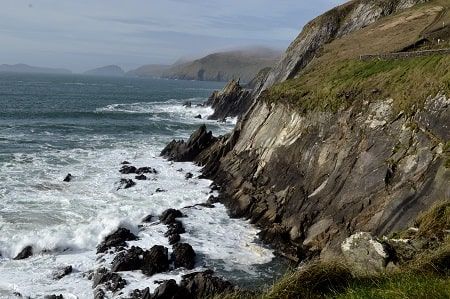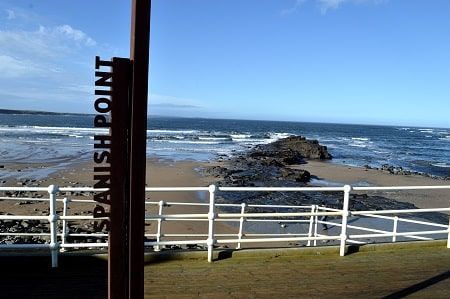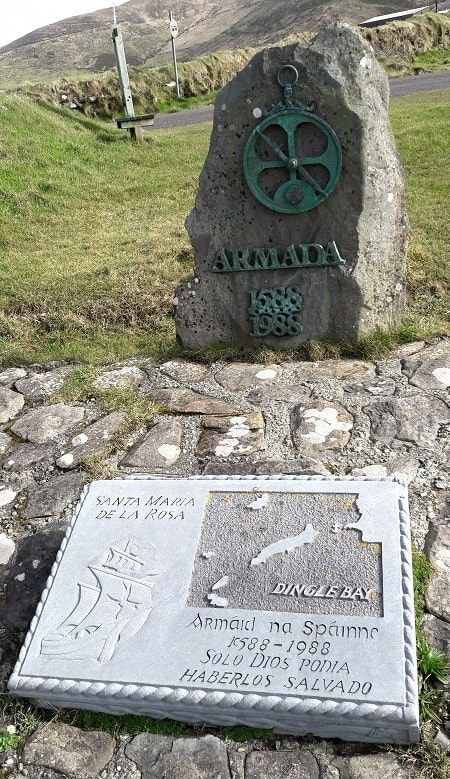The traces of Philip II's "Great Armada" in Ireland
A succession of storms and gales struck in the autumn of 1588 when a large number of ships of Philip II's Great Armada were returning to Spain. There were 24 shipwrecks. This tragedy took place in some of the most beautiful places on the west coast of Ireland.

In the autumn of 1588, when a large number of ships of Philip II's Great Armada were returning to Spain, they were surprised by a succession of storms and gales. There were 24 shipwrecks. The tragedy took place in some of the most beautiful places on the west coast of Ireland.
On May 20, 1588, a squadron of 127 ships departed from Lisbon, in the so-called "Great and Most Happy Armada", or "Company of England". The operation was planned by Philip II to dethrone Elizabeth I for the execution of Mary Stuart, the anti-Spanish policy of piracy, and the Flanders War. It took place within the context of the "Anglo-Spanish War" (1585-1604). The attack failed, but the conflict lasted 16 more years and ended with the Treaty of London of 1604, favorable to Spain.
The expedition, or Gran Armada, began to have problems from the beginning. Various storms caused the fleet to break up at La Coruña and in the Gulf of Bilbao. But 122 ships entered the English Channel and attacked different English positions. They had to skirt the coasts of England, Scotland, and Ireland. In the Atlantic coasts of Ireland, due to a succession of storms, many ships were wrecked, although 87 returned to Spain.
On August 21, 1588, the Armada left the Orkney Islands behind to enter the North Atlantic. Up to that point, 112 ships remained unscathed. But with autumn came the hurricane-force winds that battered the Atlantic coasts of Ireland. The result was tremendous: 24 shipwrecks.
The tragedy took place in some of the most beautiful places on the west coast of Ireland, such as the sandy Kinnagoe Bay. It was clear that the storms in Ireland were more effective than the English ships, faster and better armed, which were only able to sink 7 Spanish ships.

Francisco de Cuéllar
The most famous castaway of the Great Spanish Armada was Captain Francisco de Cuéllar, from Segovia. Without knowing how to swim, he survived the shipwreck of the "Lavia", a ship that together with the "Juliana" and the "Santa María de Visón" disintegrated on the beach of Streedagh Strand (County Sligo).
After the shipwreck, Cuellar would live an incredible adventure, narrated in a text he wrote a year later in Antwerp, where he narrates the vicissitudes of his odyssey through the lands of Ireland: The sandy Streedagh, the remains of O'Rourke Castle where Cuellar found shelter, or the ruins of Rossclogher's fort in the waters of Lough Melvin, where, with the peaks of the Dartrys Mountains as a backdrop, he emerged victorious with a handful of compatriots after 17 days of English siege.
Cuellar's ship was not the only victim of the Great Storm of September 21, 1588. The "Great Grin" was pushed by the gale up to Clew Bay (County Mayo), running aground off Clare Island, where more than 200 men drowned. The hundred or so sailors who survived, under the command of Pedro de Mendoza, became prisoners of Dowdarra Roe O'Malley. Days after their capture, they decided to escape from the island. The revolt ended the lives of 74 Spaniards, including Pedro de Mendoza.
A storm between September and October 1588 ate galleons and galleys such as the "Gerona" (its treasures are in the Ulster Museum in Belfast), "La Trinidad Valencera", the "Duquesa Santa Ana", the "San Nicolás", the "Nuestra Señora de Begoña", the "San Marcos"... six thousand sailors died.
The Dingle Peninsula
The rugged coastline of the Dingle Peninsula (County Kerry) was the scene of the struggle for survival of ships such as the "San Juan de Portugal", owned by Juan Martínez de Recalde; and the "San Juan Bautista", owned by Marcos de Aramburu. Sheltered in the Blasket Sound channel, the space between the Blasket Islands and the shores of the small town of Dunquin, these two ships survived the gale of September 21: they managed to return to Spain.
Less fortunate were the "San Juan", owned by Fernando Horra, and the "Santa Maria de la Rosa", which sank with the entire crew. There was only one survivor: Giovanni Manona, a young man who would originate a legend about a fabulous treasure of gold coins that the "Santa Maria de la Rosa" would transport. The legend has taken root in the pubs of Dunquin.
In front of the place where the "Santa Maria de la Rosa" wrecked, there is a monolith. A text in Spanish reads: "Only God could have saved them". Indeed, if God had existed, if he had wanted to, he would have saved them. But he did not want to.
In many coastal towns, between Bunberg and Blasket Island, there are people who "remember" the misfortunes of a Spanish shipwreck off their coasts, in the Atlantic... and that has been more than 400 years (it is difficult to accept so much memory). And they add details of their own to enrich the story and increase the drama.
The "San Marcos", built-in 1585, in Cantabria, was one of the jewels of the Spanish Navy. Commanded by the Marquis of Peñafiel, it displaced 790 tons and had 33 bronze cannons, 17 breeches, and 16 sacres. The ship was moved by 140 sailors. It carried 350 soldiers (Marines). She sank near the "Spanish Point", in County Clare. They were caught in a hellish storm, with wind gusts of 100 kilometers. The captain sought shelter between Mutton Island and the coast. The ship was wrecked on the afternoon of September 20, 1588, after hitting a shoal near Mutton Island. Of the 490 men on the galleon, only 4 are said to have made it to land (21 other shipwrecks from different periods have been recorded in the same place).

Spanish Point
At the place known as "Spanish Point", between Milltown Malbay and Quilty (County Clare) the "San Esteban" and the "San Marcos" were wrecked. A monolith inaugurated by King Juan Carlos on July 2, 1986, recalls the events, which have become a legend among the locals, who refer to the shipwreck as "Tuama na Spainteach" (the tomb of the Spaniards). The oral tradition assures that the castaways of those two ships, mercilessly executed by Boetius Clancy, representative of the English crown in Clare, are buried there.
Spanish Point is located very close to Milltown Malbay, which is the largest town in the area, with just over 700 inhabitants. Spanish Point is a hamlet of 80 neighbors, with many summer residences that, in winter, remain closed. During that cold and rainy season, it has hardly any population.
The name "Spanish Point" (Rinn na Spáinneach) refers to the shipwreck of some ships of the Spanish Armada of Philip II, during a great storm on the Atlantic coasts of Ireland.
The galleon "San Esteban" was wrecked 12 kilometers south of the "Spanish Point". More than 300 men drowned: there were only 60 survivors who were captured by Boetius Clancy, together with the 4 of the "San Marcos". The representative of the English crown carried out the orders: the survivors were hanged. Not even Philip of Cordoba was spared, one of the surviving promenaders for whom a large ransom would have been paid. The place has been known ever since as "The Hill of the Gallows".
Quilty is a small fishing village between Milltown Malbay and Dunberg. Across the bay from Quilty is Mutton Island (Lamb Island), another of the scenes of the shipwrecks of the Navy. The island doesn't have much to see: a tower, from the 19th century, when the Irish feared a Napoleonic invasion; and the remains of a prison, from the 20th century. At low tide and with special conditions, you can walk along a limestone path from Seafield, near Quilty, to Mutton Island. There is a memorial to the drowned sailors who died in the storm.
Irish folklore is rich in legends. The shipwrecks occupy a good part of the popular songs, which remember places and dates. The shipwrecks of the Armada of Philip II have originated the legend of the "Black Irish", the brown Irish with brown eyes. But the truth is that in the south of Ireland there is a good percentage of black-haired and brown-eyed Irish. The ships of Philip II's Armada were not the only ones that sank off the coast of Ireland. There must have been other influences in addition to the Spanish.

The Illagh Massacre
On the outskirts of Derry is the castle of Illagh and in its vicinity, a wooden cross. In that place rest the remains of 400 Spaniards who were in "La Trinidad Valencera", commanded by Alonso de Luzón, commander of the Tercios de Nápoles that, on September 16, 1588, was shipwrecked in that part of the Irish coasts. The galleon was wrecked on the reefs of the sandy Kinnagoe Bay, north of the Inishowen Peninsula (Many pieces of this ship are exhibited in the Tower Museum, Derry). After the surrender and surrender of arms, the Spaniards, more than 300 sailors, were mercilessly speared and massacred with arquebuses by the English garrison in the area.
Text and photographs: Pablo T. Guerrero




